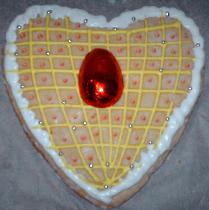Maltese cuisine
| Part of a series on the |
| Culture of Malta |
|---|
 |
| People |
| Languages |
|
Folklore |
| Cuisine |
| Festivals |
| Religion |
| Art |
|
Literature |
| Music |
| Sport |
Maltese cuisine reflects
History

Malta's history and geography had an important influence on its cuisine. Having to import most of its foodstuffs, being positioned along important trade routes, and having to cater for the resident foreign powers who ruled the islands, opened Maltese cuisine to outside influences from very early on. Foreign dishes and tastes were absorbed, transformed and adapted.
The Knights hailed from many European countries, particularly France, Italy and Spain. They brought influences from these countries.
The British military presence meant a market of a garrison and their families and, later, mass tourism from the UK. British food products, condiments and sauces like
Cuisine and identity

There are a number of junctures in which development in Maltese cuisine related to issues of identity. The most significant example is the traditional Maltese stuffat tal-fenek (rabbit stew), often identified as the national dish, quite possibly started off as a form of symbolic resistance to the hunting restrictions imposed by the
The popularity of pork and its presence in various dishes could be attributed to Malta being on the edge of the Christian world. Consuming a food which is prohibited in the Muslim culinary culture could have been a way of self-identification by distinguishing oneself from the other. In addition to pork dishes (such as grilled pork cuts or stuffed flank) and the exclusive predominance of pork in indigenous Maltese sausages, adding some pork to dishes such as kawlata (a vegetable soup) and ross il-forn (baked rice) has been common practice in the Maltese vernacular cuisine for centuries.[2]
For the
Variations


Regional
Despite Malta's small size there are some regional variations. This is especially the case with
Other Gozitan variants include the use of ingredients. Gozitan cheeselets, for example, are used as filling for ravioli instead of the usual ricotta.
Seasonal

The strongest seasonal variations are seen in desserts and sweets. Prinjolata,[8][9] kwareżimal, karamelli tal-ħarrub, ftira tar-Randan, figolla and qagħaq tal-għasel are all examples of sweets associated with a particular season.
Because Catholic fasting during
During the
During the month of November għadam tal-mejtin (lit. bones of the dead, in Italian: ossa dei morti) are prepared. These are a layer of marzipan sandwiched between sweet pastry and topped with white icing (normal icing and not buttercream icing).
Qaghaq tal-Ghasel, in English, honey rings, are a traditional Maltese sweet. They consist of a pastry with a stuffing of sorts inside, made into a ring shape, with slits along the ring for the filling to dark filling to ooze out. The filling is traditionally a mixture of
See also
References
- ^ What they ate[permanent dead link], Heland Project
- ^ a b Billiard, E. (2010), Searching for a National Cuisine, Journal of Maltese History, Vol. 2, No. 1
- ^ Destremeau, D., Malte Tricolore
- ^ Bonello, G. (2000) The Maltese who Pioneered Chocolate in Europe in Histories of Malta – Deceptions and Perceptions, Vol.1 [1] Archived 4 April 2013 at the Wayback Machine
- ^ Cassar, C. Fenkata: An emblem of Maltese peasant resistance?] quoted in Gauci-Maistre, J. Tax-xiber: the indigenous rabbit of Malta
- ^ "Gauci-Maistre, J. Tax-xiber: the indigenous rabbit of Malta" (PDF). Retrieved 26 August 2012.
- ^ "Medinaportal". Medinaportal.net. Archived from the original on 19 December 2017. Retrieved 12 December 2017.
- ^ "Medinaportal". Medinaportal.net. Archived from the original on 1 December 2017. Retrieved 12 December 2017.
- ^ Vella, Marie Cooking the Maltese Way 2nd Edition published in Valletta Malta by Cordina's Emporium
- ISBN 99909-79-00-6.

